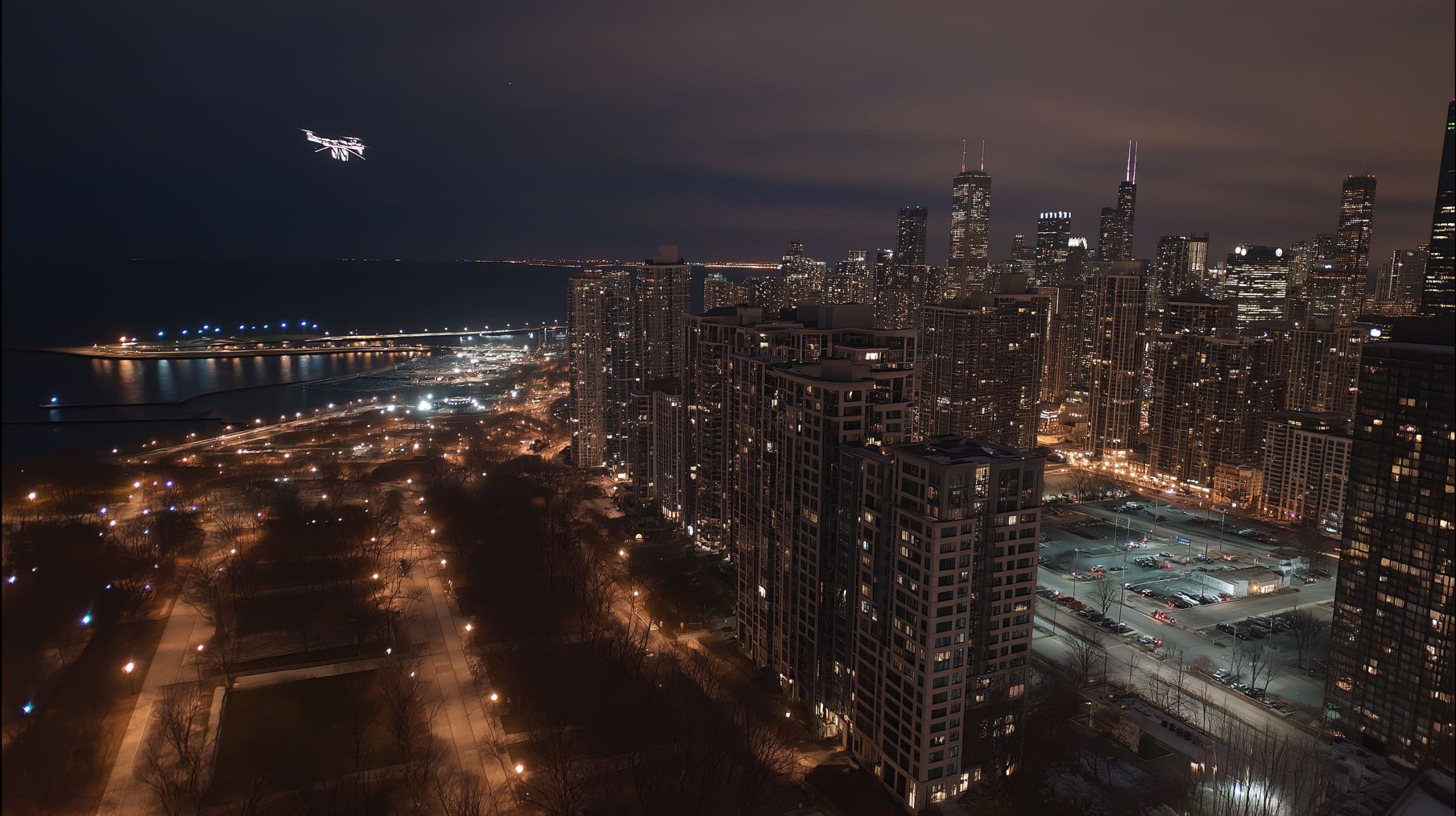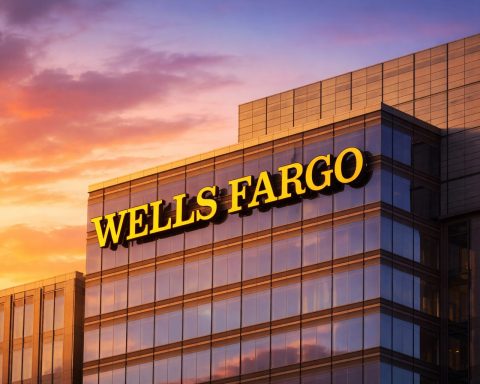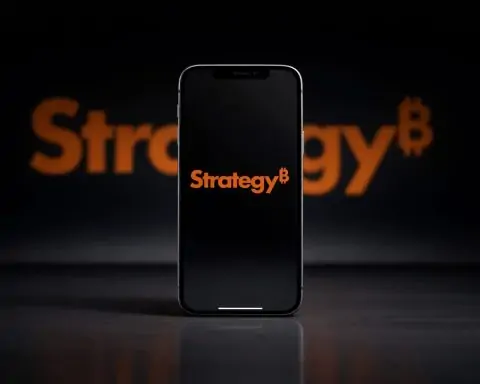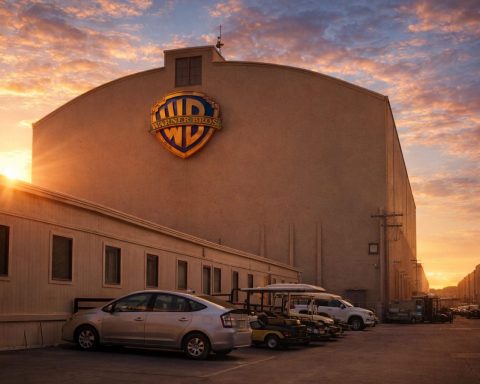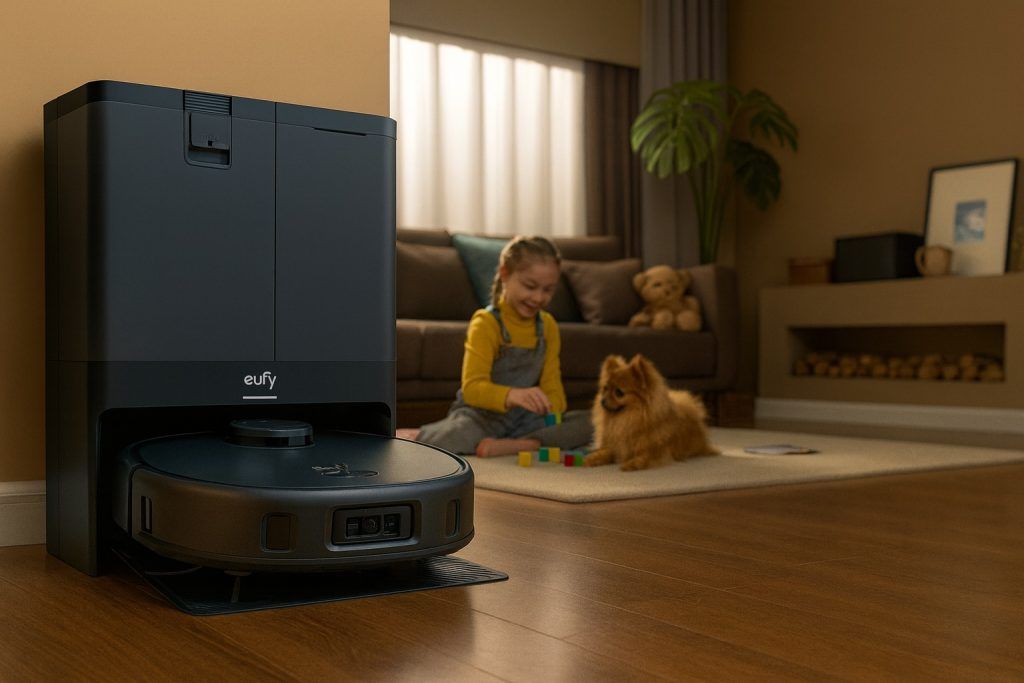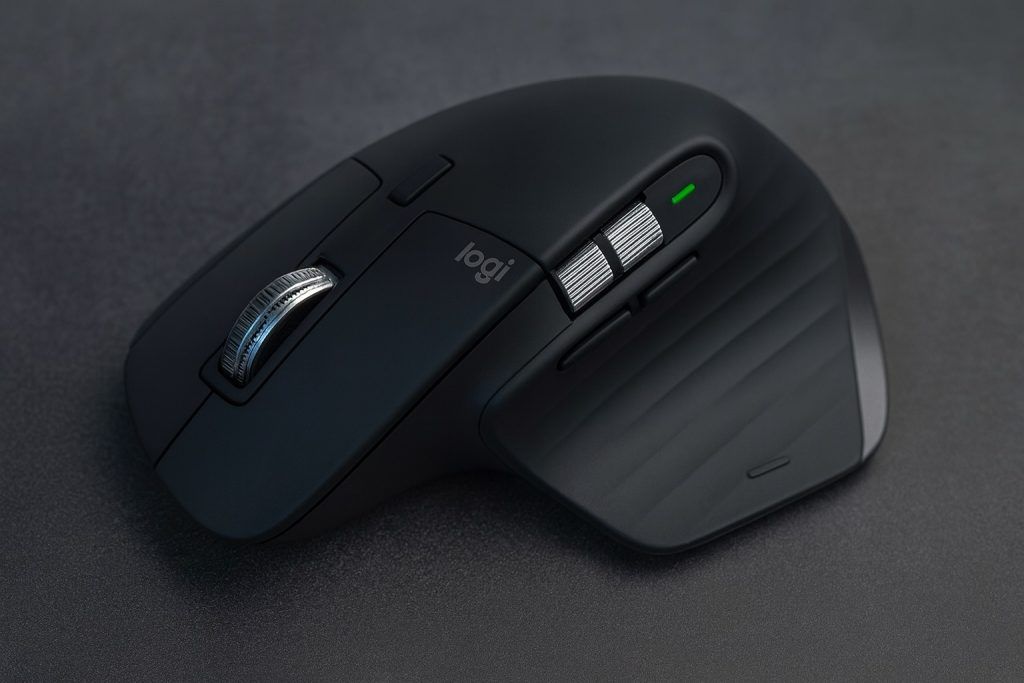-
<li Drone registration is required for drones over 0.55 pounds (250 grams), with a $5 fee via the FAA DroneZone and a validity of three years.
<li Since 2023, FAA Remote ID is required for most drones, with a compliance deadline of March 16, 2024, and flying without Remote ID can result in FAA fines or suspension of your pilot certificate.
<li Recreational flyers must pass the Recreational UAS Safety Test and follow FAA model aircraft rules, including visual line of sight, under 400 feet, and yielding to manned aircraft.
<li Commercial operators must hold an FAA Remote Pilot Certificate (Part 107) and obtain airspace authorization (e.g., LAANC) before flying in controlled airspace around airports, with night operations allowed only under specific waivers and lighting conditions.
<li During major Chicago events, the FAA enforces a no-drone zone within a 3-mile radius and up to 3,000 feet above ground level, beginning one hour before and ending one hour after the event.
<li Chicago imposes a 5-mile no-fly radius around airports, and drones near O’Hare (ORD) and Midway (MDW) require FAA clearance due to ORD Class B and MDW Class C airspace.
<li Illinois privacy law HB 3906 makes it illegal to use a drone to invade someone’s reasonable expectation of privacy, with violations typically charged as a Class A misdemeanor (up to one year in jail).
<li Park District rules prohibit drones in most city parks, beaches, and Park District property, with Lincoln Park Flying Field near Montrose Harbor listed as a designated model aircraft site.
<li Downtown Chicago film operations require a Chicago Film Office permit, a flight plan reviewed by authorities, and may involve street closures or off-duty safety personnel.
<li Chicago imposes no-fly restrictions around critical infrastructure, requiring drones to stay 500 feet from water intake facilities or water treatment plants, 100 feet from electrical transmission lines, and 25 feet from overhead wires along public ways; violations may be fined and the drone seized.
Drone enthusiasts and professionals in Chicago face a complex web of regulations at the federal, state, and city levels. The Federal Aviation Administration (FAA) sets nationwide rules (like requiring drone registration and Remote ID), while Illinois state laws add privacy and wildlife protections. On top of that, the City of Chicago enforces one of the nation’s strictest local drone ordinances, originally passed in 2015 and updated in 2018 and 2023 [1]. This comprehensive guide breaks down Chicago’s drone laws for both recreational flyers and commercial operators, covering everything from FAA requirements to local no-fly zones, permits, and penalties. By understanding these rules, drone pilots can avoid hefty fines or confiscation of their drones and enjoy the skies legally [2].
Federal Drone Laws and FAA Regulations
All drone pilots in Chicago must follow federal laws set by the FAA, which apply uniformly across the U.S. Key FAA regulations include:
- Drone Registration: Drones weighing over 0.55 lbs (250 grams) must be registered with the FAA and marked with a registration number. Failing to register can lead to significant fines [3] [4]. Registration is done via the FAA DroneZone website for a $5 fee and is valid for three years [5].
- Remote ID Requirement: As of 2023, most drones must comply with the FAA’s Remote Identification rule. Drones must broadcast identification information (like a digital license plate) during flight, either via built-in capability or an add-on module. The FAA gave a grace period for compliance, but after March 16, 2024, flying a required drone without Remote ID can result in FAA fines or even suspension of your pilot certificate [6] [7]. Remote ID helps authorities locate the operator if a drone is flying unsafely or where it isn’t allowed [8].
- Recreational Flyers (Hobbyists): Hobby pilots must pass the Trust test (The Recreational UAS Safety Test) and carry proof of passage [9]. They must follow the FAA’s model aircraft rules, which include flying only for fun, keeping the drone within visual line of sight at all times, flying under 400 feet altitude, and yielding to manned aircraft. Recreational drones should not fly in controlled airspace (e.g. near airports) without prior authorization. Apps like FAA B4UFLY can help hobbyists check for airspace restrictions [10].
- Commercial Operators: Anyone flying a drone for business, work, or any commercial purpose in Chicago must hold an FAA Remote Pilot Certificate (Part 107 license) [11]. To get certified, a pilot must pass an FAA aeronautical knowledge exam. Part 107 rules mirror many hobbyist rules but also explicitly prohibit operations like flying over uninvolved people or moving vehicles and night flying without special waiver or training. (Recent FAA rule changes allow night flights and flying over people under certain conditions for Part 107 operators, but appropriate anti-collision lighting and additional training are required.) Commercial pilots must request airspace authorization (e.g. via LAANC) before flying in controlled airspace around airports. They are also subject to Remote ID and registration requirements just like hobbyists.
- Government Operators: Government agencies (e.g. police, fire departments) in Illinois may operate under Part 107 or obtain a Certificate of Authorization (COA) from the FAA [12]. Law enforcement use of drones is further constrained by state law (as discussed below in the Illinois section).
Federal no-fly zones: Note that federal law prohibits drone operations in certain sensitive areas nationwide, which affect Chicago as well. For example, drones cannot fly in the immediate proximity of commercial airports without clearance, nor over Temporary Flight Restrictions (TFRs) that may pop up for events (such as stadium sports games or VIP visits). During major sporting events at Chicago’s stadiums (e.g. NFL or MLB games), the FAA enforces a no-drone zone within a 3-mile radius and up to 3,000 ft AGL, starting one hour before until one hour after the event. Always check NOTAMs/TFRs and use apps to stay updated on any temporary restrictions in Chicago’s airspace [13].
Illinois State Drone Laws
Illinois has enacted several state laws addressing drones, and these apply to Chicago operators in addition to federal rules:
- Statewide Preemption (except Chicago): Illinois law pre-empts local drone regulations and reserves authority to the state, with one major exception. Illinois Senate Bill 3291 (2018) prohibits units of local government from regulating drone use, except home-rule municipalities with over 1,000,000 residents [14]. Chicago—being over the population threshold—is exempt from this preemption and allowed to have its own drone ordinance. Smaller cities and towns in Illinois generally cannot enact their own drone laws. This means Chicago’s regulations (detailed in the next section) are uniquely stringent, whereas elsewhere in Illinois, only federal and state laws (but not additional city laws) would typically apply.
- Privacy Law (Aerial Trespass): Illinois has criminalized certain invasive uses of drones. House Bill 3906 (amending the Criminal Code) makes it unlawful to use a drone to knowingly enter the airspace above or around someone’s private residence to record video or otherwise violate their reasonable expectation of privacy [15]. In simpler terms, spying on someone at home with a drone camera without consent is illegal. Violations can be charged as a Class A misdemeanor (which in Illinois is punishable by up to a year in jail and fines up to $2,500). Chicago’s own ordinance also reinforces privacy by banning drone “surveillance” without permission by law [16], so both state and city law protect people from intrusive drone use.
- Interference with Hunters or Wildlife: Illinois law protects wildlife and hunting activities from drones. House Bill 1652 (2013) and existing wildlife code (520 ILCS 5/2.33) make it illegal to use a drone to interfere with another person’s lawful hunting or fishing [17]. It’s also unlawful to use drones to harass or disturb wild birds or mammals, except for legitimate purposes like inspecting utility facilities [18]. While these scenarios are more likely outside urban Chicago, a drone pilot could face charges for, say, trying to scare away game animals or disrupt anglers with a drone.
- Law Enforcement Drone Use – Freedom from Drone Surveillance Act: Illinois’ Freedom from Drone Surveillance Act (originally SB 1587/2937 in 2013-2014) restricts how police and state agencies can use drones. In general, law enforcement in Illinois must obtain a warrant to use a drone for surveillance, with only limited exceptions such as certain emergencies, terrorist threats, missing person searches, or imminent danger to life [19] [20]. Even when police do use drones, the law requires that any information collected be destroyed within 30 days unless it contains evidence of a crime [21]. These state rules don’t directly govern private drone pilots, but it’s good context – and Chicago’s ordinance explicitly defers to this Act for police drone operations [22].
- No Drone Weaponization: While not unique to Illinois (federal law also forbids operating an armed drone), state law and local Chicago law make it clear you cannot equip a drone with a firearm or weapon. Chicago’s ordinance expressly bans drones “that are equipped with a firearm or other weapon” [23]. Doing so would likely violate multiple laws (and common sense), leading to serious legal consequences.
Aside from these, Illinois has no broad additional licensing or insurance requirements for drones – so the primary rules remain FAA’s regulations and Chicago’s local ordinance. The state mainly focuses on specific misuse scenarios (privacy, hunting interference, law enforcement oversight) and allowing Chicago to set its own stricter standards.
City of Chicago Drone Ordinance (Municipal Code 10-36-400)
Chicago’s municipal drone law is one of the most comprehensive local drone regulations in the country. Municipal Code §10-36-400 (“Small Unmanned Aircraft”) governs where and how you can fly within city limits. Enacted in late 2015, this ordinance imposes many additional restrictions beyond federal law to protect safety, privacy, and critical infrastructure [24] [25]. Key rules in the City of Chicago include:
- Recreational-Only by Default: No one may operate a drone in Chicago “except for hobby or recreational purposes” unless they have specific FAA authorization for commercial operations [26] [27]. In practice, this means casual hobby flying is allowed (subject to all other rules), but commercial drone flights require an FAA-licensed Remote Pilot (Part 107) and must comply with any FAA waivers or certificates obtained [28]. Chicago acknowledges FAA licenses/waivers – a Part 107 certificate or other FAA authorization effectively grants permission to operate commercially in the city as long as you still follow all local safety restrictions.
- No Flying Over People or Private Property Without Consent: It is illegal to fly a drone over any person who isn’t participating in the operation, unless that person gave permission [29]. Similarly, you cannot fly over someone else’s private property without the property owner’s consent [30]. These rules mean you should not buzz over strangers in a park, nor take off or land on private land without permission. Even if you have consent, endangering people on the ground is not allowed (FAA rules also prohibit careless endangerment).
- 400 ft Altitude Limit: Chicago codifies the 400 feet above ground level (AGL) ceiling that aligns with FAA hobby and Part 107 rules [31]. Flying higher than 400 ft AGL in city airspace is prohibited without special authorization.
- Visual Line-of-Sight Required: You must keep your drone within your own natural visual line of sight at all times (binoculars or first-person-view goggles do not count) [32]. Flying beyond line-of-sight (BVLOS) is not allowed in Chicago without FAA exemptions, and even then, Chicago would likely treat it as unsafe unless explicitly authorized.
- No Night Flying:Drone operations are banned between dusk and dawn under the city ordinance [33]. Only daylight flights are permitted. (The FAA now allows night flying for certified pilots with anti-collision lighting, but Chicago’s law still lists nighttime as off-limits unless perhaps one obtains an FAA waiver. As of 2025, assume you cannot fly at night in Chicago legally, unless authorities say otherwise.)
- No-Fly Near Airports (5-Mile Rule): Chicago makes it unlawful to fly within 5 miles of any airport without proper authorization [34]. This is stricter than current FAA hobby rules, which require authorization in controlled airspace rather than a blanket 5-mile radius. However, the city ordinance’s 5-mile rule essentially covers Chicago’s two major airports – O’Hare and Midway – and means huge swaths of the city are off-limits unless you have FAA clearance. Practically, any drone flight in Chicago near O’Hare or Midway requires FAA Air Traffic control permission (via LAANC or written authorization). Even with FAA permission, Chicago may still enforce other safety buffers near airports. Always use apps to check how close you are to Class B or Class C airspace. (Note: Smaller airports and heliports exist too, so be mindful of those; the ordinance doesn’t name specific airports, it applies to any airport.)
- Yield to Manned Aircraft: Drones must never interfere with or fail to give way to any manned aircraft [35]. This aligns with the golden rule that drones should always yield to helicopters, planes, etc. Flying near police or news helicopters (common in downtown Chicago) is particularly dangerous and illegal.
- Weather and Line-of-Sight Conditions: You may not operate a drone when weather conditions impair your ability to fly safely [36]. For example, heavy fog, high winds, or storms would violate this rule (and common sense).
- No Flights Over Sensitive Sites: The ordinance forbids drone flights over or within certain distances of sensitive locations without permission. It is illegal to fly over open-air assemblies (outdoor events or gatherings), schools or schoolyards, hospitals, places of worship, prisons, or police stations without the property owner’s consent [37]. In essence, you can’t fly over crowds or important facilities. Chicago also uniquely bans drones near critical infrastructure: you must stay at least 500 feet away from any water intake facility or Chicago water treatment infrastructure, and 100 feet away from electric transmission facilities (high-voltage lines, substations) and 25 feet from any electric distribution lines or other wires/cables along public ways [38]. These rules are meant to prevent power outages or hazards from drone strikes. In a city as large as Chicago, it’s challenging to avoid all power lines – practically, this rule means you should not fly low near power lines or utilities, and any intentional flight near such facilities needs the owner’s consent.
- No “Surveillance” or Harassment: Using a drone to conduct unwelcome surveillance is explicitly banned, “unless expressly permitted by law” [39]. This dovetails with the state privacy law – Chicago will penalize drone operators who invade others’ privacy or trespass with cameras. Similarly, you cannot use a drone to harass people. The ordinance also prohibits operating a drone with the intent to cause harm to persons or property [40] or in a reckless or careless manner [41]. Basically, any malicious or irresponsible drone use is unlawful.
- No Weapons or Hazardous Payloads: Equipping a drone with any firearm or other weapon is strictly illegal in Chicago [42]. Attaching fireworks, explosives, or similar dangerous items would also fall under “harm to persons or property” and other laws. (Flying with any item that could drop and injure someone is a bad idea – even if not explicitly a “weapon,” it could be deemed reckless.)
In summary, Chicago’s drone ordinance heavily restricts urban drone flying. It mirrors many FAA rules (400 ft limit, VLOS, no over people) and adds further local bans (parks, 5-mile airport zone, etc.). The law’s default stance is that drone operations must be hobbyist and low-risk; anything more specialized (commercial, advanced operations) requires proper FAA credentials and adherence to all conditions.
Enforcement and Penalties (City Ordinance): Violating Chicago’s drone law carries stiff penalties. Each offense can result in a fine of $500 up to $5,000 and even up to 180 days in jail [43]. Each day a violation continues is considered a separate offense. For example, repeatedly flying a drone illegally on multiple days could compound fines quickly. In addition, Chicago authorities are empowered to seize your drone if it’s flown unlawfully. The ordinance allows police, the Mayor’s office, or the aviation department to confiscate a drone used in violation and hold it pending a hearing [44]. The owner may have to pay storage fees ($20/day) and retrieval costs to get it back, and if there are criminal charges, the drone can be held as evidence. In egregious cases, the drone might not be returned at all if the courts deem the seizure appropriate. In practice, this means if you are caught flying somewhere you shouldn’t (say, over a crowd downtown or in a restricted area), you risk not only a ticket but also losing your equipment. Chicago’s message is clear: drone violations can lead to hefty fines, confiscation of your drone, and legal action [45].
No-Fly Zones and Airspace Restrictions in Chicago
Between federal rules, state rules, park policies, and the city ordinance, many areas in Chicago are effectively “no-fly zones” for drones. Here are the most important airspace restrictions and locations where drones are prohibited or limited:
Airports and Controlled Airspace
Chicago is home to two busy commercial airports – O’Hare International (ORD) and Midway International (MDW) – as well as several smaller airports and heliports in the region. By law, drones cannot fly near airports without permission. The City of Chicago bans drone operations within a 5-mile radius of any airport absent FAA authorization [46]. This covers all of O’Hare’s and Midway’s approach corridors (and indeed much of the city’s airspace falls under this rule). The FAA classifies O’Hare’s airspace as Class B and Midway’s as Class C; any drone flight in controlled airspace must receive prior FAA clearance (through LAANC or FAA DroneZone). Recreational flyers and Part 107 pilots alike need approval to fly in these areas, and even then must stay below assigned altitudes. Simply put, O’Hare and Midway are no-fly zones without explicit FAA permission [47].
Even with authorization, extreme caution is required. Air traffic is dense, and straying into approach paths could result in a dangerous incident and federal prosecution. Always respect the “zero tolerance” policy around airports – if you lack clearance, do not fly anywhere near them. Additionally, hospital heliports (e.g. at trauma centers like Northwestern Memorial or University of Chicago Hospital) create localized airspace concerns. While not regulated like large airports, Chicago advises pilots to avoid flying near hospitals or their helicopter landing pads out of safety for medical flights [48] [49].
Chicago Park District Properties
Chicago Park District rules make virtually all city parks off-limits to drones. The Park District has explicitly prohibited drone flying in parks, beaches, and other property under its control, except in designated model aircraft fields [50]. This means popular green spaces like Grant Park, Lincoln Park, Millennium Park, Maggie Daley Park, the lakefront parks, and neighborhood playgrounds are generally no-fly zones. The only exception is if the Park District has a specifically designated area or program for model aircraft. As of 2025, Chicago has very limited designated drone-flying zones within city limits. One known site for model aircraft is the Lincoln Park Flying Field (near Montrose Harbor), historically used by RC plane hobbyists – but pilots should confirm current status and any permit requirements. Often, Chicago drone hobbyists travel to certain Cook County Forest Preserve fields (outside the city proper) which allow model aircraft flying in designated zones [51].
Unless you’re in an approved flying field, do not take off or land a drone on Park District land. This includes the entire Chicago lakefront (since the parks along Lake Michigan are Park District property) and the Chicago Riverwalk as well. Park security and city police can ticket violators. The ban is meant to protect public safety and enjoyment of parks, as an out-of-control drone could injure patrons or disturb wildlife. Commercial operators also cannot use parks as launch sites without special permission. If a film production needs to fly in a park, they must obtain a permit and close off the area.
Downtown and Other Sensitive Locations
Downtown Chicago (The Loop) presents a challenging environment for drones and is effectively a restricted zone. The dense cluster of high-rises, constant pedestrian and vehicle traffic, and presence of multiple heliports make it very hard to fly without breaking the “no over people” and other rules. Chicago’s ordinance doesn’t outright ban drones citywide, but in practice flying in downtown areas requires special planning and often city approval. The City of Chicago’s Film Office notes that in high-traffic, populated locations like downtown, it may be impossible to avoid flying over the public. In such cases, the City requires drone operators to coordinate with authorities: you must submit your flight plan for review by the Chicago Police and other officials, and if approved, arrange for street or sidewalk closures to create a “closed set” with no pedestrians under the drone [52]. Essentially, to fly a drone for filming in the Loop, you need a film permit and must hire off-duty police or fire safety officers to secure the area [53]. This level of coordination is typically only done for professional film or TV productions. Casual hobbyists cannot practically do this, so for all intents and purposes, you should not fly a drone in downtown Chicago unless you have official permission and safety measures in place.
Beyond downtown, Chicago also forbids flights over “open air assembly units” without consent [54]. This term covers any open-air gathering of people – from festival grounds and concert venues to sports stadiums and parade routes. So, drones are a no-go over events like Lollapalooza in Grant Park, the Chicago Marathon route, street festivals, or a full Soldier Field. In fact, the FAA often issues temporary flight restrictions (TFRs) during major events (e.g., the NFL’s Bears games or large gatherings), which reinforce that no aircraft (including drones) may fly in the area. Always assume that any event with a crowd is off-limits unless you are an authorized operator working the event with clearance.
Critical Infrastructure: Chicago’s ordinance creates no-fly buffer zones around critical infrastructure sites. Drone operators must avoid flying within 500 feet of the city’s water intake facilities or water treatment plants, and within 100 feet of electrical transmission lines or 25 feet of any overhead wire over public ways [55]. Chicago has water intake cribs in Lake Michigan and pumping stations (e.g. the Jardine Water Purification Plant on the lakefront) – these are sensitive facilities, and drones should steer well clear. Power substations and the city’s electrical grid are also protected; flying too close could be viewed as a security threat or could risk collisions causing outages. Additionally, government buildings like City Hall, police stations, and correctional facilities are covered by the “no flying without consent” rule. It’s best to treat all government or utility facilities as no-fly unless you have permission from the property manager and any necessary city permits.
Private Property Considerations: While not a “no-fly zone” per se, remember Chicago bans flying over private property without the owner’s consent [56]. In a city as large as Chicago, it’s nearly impossible to fly beyond your backyard without crossing over someone else’s property (a neighbor’s yard, a business, etc.). This rule essentially means that outside of controlled environments or very large open areas, most flights will require getting permission from landowners underneath. For hobbyists doing casual flights at an empty field (not Park District land) or a friend’s farm, ensure you have the landowner’s OK. For commercial flights, location scouting and securing property permissions are a must – for example, if filming a building or flying along the river (which is city property), you’d need the relevant authority’s consent.
Permits and Special Authorizations in Chicago
Unlike some cities, Chicago does not issue a standalone “drone permit” for every flight. Instead, drone operators must navigate existing permit frameworks (like film permits) or obtain FAA authorizations when required. Here’s how to handle permissions:
- FAA Airspace Authorization: If you plan to fly within Chicago’s controlled airspace (near O’Hare, Midway, or downtown if within any Class B/C extensions), you must obtain FAA approval beforehand. Both recreational and commercial flyers can use the LAANC system (Low Altitude Authorization and Notification Capability) via apps like AirMap, Aloft, or the FAA’s DroneZone to request near-instant authorization for specific times and locations. This is mandatory for any flight in Class B or C airspace under 400 ft; without it, you violate federal law. Note that having FAA airspace authorization does not override Chicago’s local rules – you still can’t fly in a park or over people just because the FAA cleared the airspace. It simply means ATC knows about your flight and you won’t conflict with manned aircraft. Always keep proof of any FAA authorization during your flight.
- Chicago Film Permit (for commercial shoots): If you are a filmmaker or commercial drone operator wanting to shoot in the city, you’ll likely need to involve the Chicago Film Office. The city requires a film permit for shooting on public property, and this extends to drone use. As mentioned, for downtown or other busy areas, the city will only allow drone filming if you arrange for controlled conditions (emptying out the area beneath the drone). The process typically involves submitting a Drone Flight Request Form along with a film permit application [57]. The Film Office, in consultation with Chicago Police, will review your plan – including flight location, altitude, time of day, safety measures, pilot credentials, etc. If approved, you must coordinate any necessary street closures and hire city safety personnel. This process can take time and resources, so plan well in advance. Important: The Film Office explicitly lists current drone rules: a commercial operator must have a Part 107 Remote Pilot Certificate, must not fly over the general public, must stay under 400 ft and in daylight, etc. [58]. Showing you know and will follow these rules is part of getting approval.
- Flying on Park District Property: Generally, the Park District doesn’t allow drones, so there’s no publicized permit for casual use. However, if you have a compelling reason (e.g. an event demonstration or research project), you’d have to approach the Park District for special permission. They might issue a special use permit on a case-by-case basis, or direct you to one of the designated model aircraft fields. For hobbyists, the simpler route is to use those designated fields (if any are available in Chicago or nearby suburbs) or join an AMA (Academy of Model Aeronautics) club that has a field. AMA clubs often have agreements for flying sites in the region. Remember that flying in a park without permission can get you cited for violating Park District code, so it’s not advisable.
- Permissions for Private Property: If you intend to launch/land or fly low over private property in Chicago (e.g. an outdoor wedding at a venue, or inspecting a building for work), you should secure written permission from the property owner. While the city ordinance doesn’t lay out a permit process for private property flights, having the owner’s consent is legally required [59]. For higher altitude flights that just incidentally pass over others’ property, it’s a gray area, but the ordinance is written broadly (“over property the operator does not own, without the owner’s consent” is prohibited). This could be interpreted as any unauthorized overflight is illegal. In practice, enforcement may focus on obvious, low-altitude intrusions. Still, to be safe, plan flights so they remain over areas you have rights to, or get permission from any property owners in your flight path.
- Illinois Forest Preserves and Suburbs: Many surrounding jurisdictions (Cook County, etc.) have their own rules. For example, the Forest Preserves of Cook County allow drones only in certain designated flying fields and otherwise prohibit them [60]. If you venture outside Chicago to fly, always check the local city or county rules. (Illinois’s preemption law stops smaller cities from regulating drones in general airspace, but park districts and forest preserves often ban launching/landing on their property, which they are allowed to do as property rules.) In the greater Chicago area, some suburbs have specific ordinances (for instance, Schaumburg bans drones at village events [61]). So due diligence is needed wherever you go.
Bottom line: To legally fly in Chicago, ensure you have all necessary approvals – FAA airspace clearance if near airports, film permits if doing commercial shoots on city property, and property owner consent for the location. For straightforward hobby flights, pick locations that are not restricted (away from airports, outside of parks, with permission on private open land). When in doubt, contact local authorities. The Chicago Police Department can clarify if a certain spot is off-limits, and the Department of Aviation or Film Office can advise on any needed permits. It’s better to ask first than to have your drone seized for illegal operation.
Penalties and Legal Consequences
Flying a drone irresponsibly in Chicago can lead to serious legal trouble. Multiple layers of enforcement exist – local, state, and federal – and penalties can include fines, criminal charges, and losing your equipment or licenses. Here’s what’s at stake if you violate drone laws:
- City of Chicago Penalties: As noted earlier, Chicago’s ordinance sets fines of $500 to $5,000 per violation, and up to 180 days in jail for serious cases [62]. The city can charge each day you break the law as a separate offense, so ongoing illegal operations rack up multiplied penalties. Chicago police have the authority to confiscate drones flown unlawfully [63]. If your drone is seized, you’ll have to attend a hearing and pay storage fees to reclaim it, on top of any fines. Refusal to comply with a police order to land a drone, or repeat offenses, could lead to arrest. These are misdemeanor-level penalties, but they will still give you a criminal record and empty your wallet. Always respect any instruction from law enforcement regarding your drone – for instance, if an officer tells you to ground your drone in a park or restricted area, do so immediately to avoid escalating the situation.
- State Law Consequences: Illinois can prosecute certain drone misuse under state law. Violating the privacy prohibition (e.g. filming someone inside their home without consent) is typically a Class A misdemeanor, as mentioned, with up to 1 year in jail. Interfering with hunters or harassment of wildlife via drone could also bring misdemeanors (fines and potential jail time, depending on the wildlife code). While there haven’t been widely publicized cases of Illinois jailing a drone pilot for a first-time offense, the legal authority exists. State-level charges would be handled by county prosecutors. Additionally, if you were to arm a drone or use it for something like stalking, other Illinois criminal statutes (unlawful weapon use, harassment, stalking laws) would come into play. In short, misuse a drone badly enough and you could be facing criminal charges in state court, not just a city ticket.
- Federal Enforcement: The FAA primarily handles administrative enforcement (fines, license actions), but severe incidents can trigger federal criminal charges. For example, flying a drone in a way that endangers a manned aircraft can violate 18 U.S.C. § 32 (destruction of aircraft or aircraft facilities) or other federal laws, which carry prison time. In recent years, the FAA has aggressively fined drone operators for reckless flights – fines have ranged from a few hundred dollars for minor infractions up to tens of thousands of dollars for egregious violations (like flying in restricted airspace or over crowds deliberately). If you are an FAA-certificated Remote Pilot, you could have your license suspended or revoked for breaking regulations [64]. The FAA’s enforcement of Remote ID is also ramping up – failure to equip your drone with Remote ID after March 2024 can result in fines or certificate suspension [65]. Essentially, the FAA expects Chicago pilots to follow Part 107 or recreational rules to the letter. They can investigate incidents (sometimes using drone serials or Remote ID data to track down pilots). Be aware that federal penalties can stack on top of local penalties – you might pay a city fine and an FAA fine for the same flight if it broke both sets of rules.
- Civil Liability: Aside from government penalties, a drone operator could face civil lawsuits if their drone causes injury, property damage, or invades privacy. For example, if your drone crashes through someone’s window or hits a person, you could be sued for damages. Illinois law recognizes privacy torts – if you recorded someone in a private setting without consent, they could sue you for intrusion. While this guide focuses on laws and fines, remember that flying recklessly could cost you in civil court as well (and your insurance, if any, might not cover illegal acts).
In summary, Chicago and Illinois have given teeth to drone regulations – violations can lead to “hefty fines, confiscation of your drone, and in some cases, legal action” [66]. No drone hobbyist or business wants to end up on the news for a rogue drone incident. It’s far better to fly responsibly within the rules than to risk your bank account, freedom, or drone.
Staying Compliant and Informed
Drone laws are continually evolving. Chicago’s own rules have changed over the years (with major updates as recent as late 2023), and federal regulations also adapt as drone technology advances. Here are some final tips to ensure you stay compliant:
- Keep Learning: Before flying in Chicago, review the latest FAA guidelines on their website and check the City of Chicago’s official resources for any new local rules. Regulations can change, and authorities may issue new advisories (for example, if Chicago designates new drone flying zones or if the FAA implements new airspace restrictions). Always fly with a mindset of lifelong learning – what was legal a year ago might not be legal today if laws have changed.
- Use Technology Aids: Utilize smartphone apps like FAA B4UFLY, Airmap, or Kittyhawk (Aloft) to identify no-fly zones and request airspace authorizations. These tools show real-time maps of restricted areas, NOTAMs, and can help you avoid inadvertent violations. Before each flight, do a quick airspace check – especially in a patchwork airspace like Chicago’s. Apps can also update to reflect temporary restrictions (like a lakefront festival TFR or a VIP movement).
- Plan Your Flight Location Wisely: Given Chicago’s many restrictions, consider flying in less congested areas or official model airfields. For recreational fun, it might be worth driving to an AMA field or open area outside the city’s dense core. If you’re in Chicago, perhaps stick to the perimeter of the city or industrial areas (with owner permission) for practice flights. Avoid downtown and crowded parks unless you have authorization. By choosing a safe location, you eliminate many legal risks at once.
- Respect Privacy and Property: Always imagine how you’d feel if a drone appeared over your backyard or outside your apartment window. Give people their space – Chicago’s laws demand it, and it’s also the courteous thing to do. If you want to take skyline photos, do so from a lawful vantage point and altitude, not by hovering over someone’s rooftop without asking. When in residential areas, keep your drone high enough and over public roads (if safe) rather than low over yards.
- When in Doubt, Don’t Fly: Finally, if you’re unsure whether a planned flight is allowed, err on the side of caution. You can reach out to the Chicago Department of Aviation or Chicago Police Non-Emergency line for clarification on local drone questions. There are also local drone user groups and forums where pilots discuss safe spots to fly and experiences with authorities. It’s better to postpone a flight and get clarity than to risk an illegal flight.
By following federal, state, and local rules, Chicago drone pilots – both hobbyists and professionals – can enjoy this exciting technology while keeping the skies safe. The Windy City’s stunning architecture and lakefront are certainly tempting for drone photography, but always make legality and safety your top priorities. Fly smart, and you won’t run afoul of Chicago’s drone laws. Happy (and responsible) flying!
Sources: Federal Aviation Administration (FAA) regulations and press releases [67] [68]; Illinois General Assembly and state law summaries [69] [70]; City of Chicago Municipal Code §10-36-400 [71] [72]; Chicago Park District and local policy guides [73] [74]; Chicago Film Office guidelines [75]; UAV/drone law resources and news updates [76] [77].
References
1. codelibrary.amlegal.com, 2. www.chicagoantievictioncampaign.com, 3. www.chicagoantievictioncampaign.com, 4. www.chicagoantievictioncampaign.com, 5. uavcoach.com, 6. www.faa.gov, 7. www.faa.gov, 8. www.faa.gov, 9. uavcoach.com, 10. www.chicagoantievictioncampaign.com, 11. uavcoach.com, 12. uavcoach.com, 13. www.chicagoantievictioncampaign.com, 14. pilotinstitute.com, 15. pilotinstitute.com, 16. codelibrary.amlegal.com, 17. pilotinstitute.com, 18. pilotinstitute.com, 19. pilotinstitute.com, 20. pilotinstitute.com, 21. uavcoach.com, 22. codelibrary.amlegal.com, 23. codelibrary.amlegal.com, 24. codelibrary.amlegal.com, 25. codelibrary.amlegal.com, 26. codelibrary.amlegal.com, 27. codelibrary.amlegal.com, 28. codelibrary.amlegal.com, 29. codelibrary.amlegal.com, 30. codelibrary.amlegal.com, 31. codelibrary.amlegal.com, 32. codelibrary.amlegal.com, 33. codelibrary.amlegal.com, 34. codelibrary.amlegal.com, 35. codelibrary.amlegal.com, 36. codelibrary.amlegal.com, 37. codelibrary.amlegal.com, 38. codelibrary.amlegal.com, 39. codelibrary.amlegal.com, 40. codelibrary.amlegal.com, 41. codelibrary.amlegal.com, 42. codelibrary.amlegal.com, 43. codelibrary.amlegal.com, 44. codelibrary.amlegal.com, 45. www.chicagoantievictioncampaign.com, 46. codelibrary.amlegal.com, 47. www.chicagoantievictioncampaign.com, 48. www.chicagoantievictioncampaign.com, 49. www.chicagoantievictioncampaign.com, 50. www.chicagoantievictioncampaign.com, 51. fpdcc.com, 52. www.chicago.gov, 53. www.chicago.gov, 54. codelibrary.amlegal.com, 55. codelibrary.amlegal.com, 56. codelibrary.amlegal.com, 57. www.chicago.gov, 58. www.chicago.gov, 59. codelibrary.amlegal.com, 60. fpdcc.com, 61. pilotinstitute.com, 62. codelibrary.amlegal.com, 63. codelibrary.amlegal.com, 64. www.faa.gov, 65. www.faa.gov, 66. www.chicagoantievictioncampaign.com, 67. www.faa.gov, 68. www.faa.gov, 69. pilotinstitute.com, 70. pilotinstitute.com, 71. codelibrary.amlegal.com, 72. codelibrary.amlegal.com, 73. www.chicagoantievictioncampaign.com, 74. www.chicago.gov, 75. www.chicago.gov, 76. uavcoach.com, 77. www.chicagoantievictioncampaign.com
